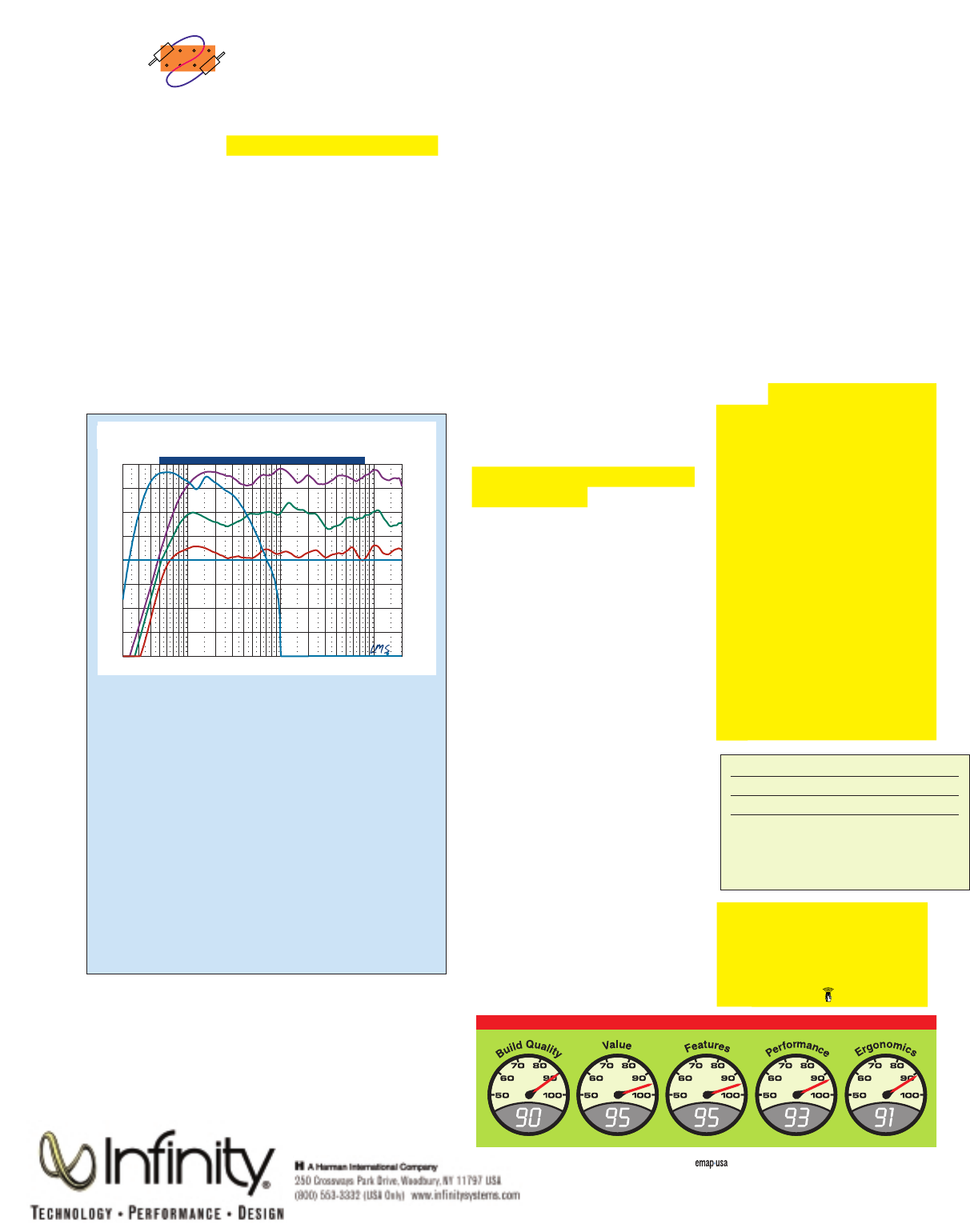
put them at the top of their class
in this department (which tells
you just how good they sound with
music). The IL25c is a nice little
center and is certainly par for the
course in terms of performance,
but there’s only so much a speaker
of this size can do when so much
emphasis is being placed on it.
Voicing was dynamic and intelligi-
ble; however, like virtually every
model its size, the IL25c displayed
some boxiness and hollowness on
occasion. The IL25c does avoid
many of the problems associated
with a horizontal alignment and
two active drivers (cancellations,
etc.), and its off-axis response was
better than many at this stature.
The IL10s handled rear effects
far more competently than most
inexpensive bookshelf models.
What they lacked in diffusion, they
made up for in accuracy and quick
attack. With properly mixed sound-
tracks, I don’t think you’ll find
yourself pining away for dipoles.
The soundfield was consistent all
around, with very few holes. If
you’re concerned about it, those
of you with seven-channel setups
could add a pair of dipoles on the
side, move the IL10s to the rear
(for soundtracks), and have the
best of both worlds in terms of
direct and diffuse radiation.
With soundtracks, the IL50s con-
tinued to impress. The midrange
and tweeter left little to be desired,
and R.A.B.O.S. successfully han-
dled the few aspects of the bass
that I didn’t like initially. I still had
the kit from the Prelude review, so
I went ahead and put the towers
through their paces. Naturally, I
found that the frequency-response
results were very similar to those
of the Preludes. Our room’s notice-
able spike at 49 hertz was the main
concern, and I was able to tame
this for the most part. Remember
that this is an attenuation-only
filter, which essentially means
that it goes after spikes, not dips.
Equalizers are usually unsuccess-
ful with dips anyway, and this is
the type of fill-in trickery that has
given equalizers a bad name. As
they did with music, the IL50s’ subs
showed a wide range of output
options for soundtracks. You can
have it big and boomy, tight and
quick, or anywhere in between. I’ll
reiterate that the tight-and-quick
option with these subs doesn’t take
that much away from the physical
impact that people like so much
with soundtracks. If you ask me,
physical impact has more to do
with accuracy than it does with raw
power. Sure, big, mushy bass may
rattle the walls more. Without defi-
nition, though, where’s the real
physical engagement and believ-
ability? The bottom line is, the
IL50s should have you covered,
no matter what your taste may be.
Here’s another bottom line: If
you’re looking for speakers in this
price range, you’re cheating your-
self if you don’t at least give the
Interludes a listen. Even the least
expensive Interlude system, which
is what I reviewed here, is easily
at the top of its class. Frankly,
I’ve heard plenty of speakers that
cost a lot more and don’t offer
this type of driver and design
quality, this degree of control,
and (most importantly) this level
of sonic performance. I never
endorse a particular speaker or
system for all circumstances, but
I’ll tell you this—at this price,
you simply can’t go wrong with
these speakers.
IL50 Tower Speaker $1,300/pair
IL25c Center-Channel Speaker $300
IL10 Bookshelf Speaker $400/pair
Infinity Systems
(800) 553-3332
www.infinitysystems.com
Dealer Locator Code IFY
Infinity Interlude Speaker System
20 Frequency 100 500 1k Hz 5k 10k 20k
C
dB spl
90
85
80
75
70
65
60
55
50
Deg
0.20
0.15
0.10
0.05
-0.00
-0.05
-0.10
-0.15
-0.20
< Magnitude > Sound Pressure Level < Phase >
HT Labs Measures: Infinity Interlude Speaker System
This graph shows the quasi-anechoic (employing close-miking of all woofers) fre-
quency response of the IL50 L/R (purple trace) and its built-in subwoofer (blue
trace), the IL25c center channel (green trace), and the IL10 surround (red trace).
All passive loudspeakers were measured at a distance of 1 meter with a 2.83-volt
input and scaled for display purposes.
On-axis response of the IL50 measures +1.50/–2.03 decibels from 200 hertz to
10 kilohertz. The –3dB point is at 92 Hz, and the –6dB point is at 76 Hz. Impedance
reaches a minimum of 5.40 ohms at 15.79 kHz and a phase angle of –66.24 degrees
at 4.74 kHz. Sensitivity averages 87.5 dB from 500 Hz to 2 kHz.
On-axis response of the IL25c measures +1.92/–3.56 dB from 200 Hz to 10 kHz.
An average of axial and (+/–15 degree) horizontal responses measures +1.44/–4.02 dB
from 200 Hz to 10 kHz. The –3dB point is at 79 Hz, and the –6dB point is at 66 Hz.
Impedance reaches a minimum of 5.33 ohms at 17.87 kHz and a phase angle of
–53.56 degrees at 5.65 kHz. Sensitivity averages 89.5 dB from 500 Hz to 2 kHz.
On-axis response of the IL10 measures +1.49/–1.61 dB from 200 Hz to 10 kHz.
The –3dB point is at 59 Hz, and the –6dB point is at 52 Hz. Impedance reaches a
minimum of 5.60 ohms at 188 Hz and a phase angle of –65.50 degrees at 5.65 kHz.
Sensitivity averages 86.5 dB from 500 Hz to 2 kHz.
Close-miked response of the IL50’s built-in sub, normalized to the average level
from 40 to 80 Hz, indicates that the lower –3dB point is at 37 Hz and the –6dB point is
at 33 Hz. The upper –3dB point is at 227 Hz with the low-pass filter set to zero.—AJ
Infinity Interlude Speaker System
PRINTED IN U.S.A. COPYRIGHT 2001 , INC. ALL RIGHTS RESERVED.
